| |
|

Sunday, June 8 Temple Solel~Tikkun Leil Shavuot


SUNDAY, JUNE 8 Ohr Shalom Shavuout Service


LETTER FROM JERUSALEM
Hamas acknowledges its responsibility for rocket attacks that killed 26 Israelis
By Ira Sharkansky
 JERUSALEM—Hamas is now claiming responsibility for nine attacks that killed 26 Israelis from 2002 to 2005. JERUSALEM—Hamas is now claiming responsibility for nine attacks that killed 26 Israelis from 2002 to 2005.
Hamas says that it has kept quiet about its role in these attacks until now "for security reasons." Other organizations claimed responsibility for the attacks at the time. Occasionally several groups boast about the same deed, and it may not be clear who really participated.
What can we learn from this latest revelation?
That an organization that engaged in suicide bombings has a wish for suicide.
Other indications come from each of the homemade rockets, mortar shells and katusha missiles imported from Iran through the sieve-like Egyptian control of Gaza's southern border that Hamas are firing toward Israel.
Residents of Sderot, Ashkelon, and other places that have felt the damage and death, have been mounting as much pressure as they can on the government to "do something." Leading politicians are saying that the army has prepared for an onslaught, and that the "go signal" from the politicians is coming closer every day.
The same politicians have been saying the same thing for months. They repeat themselves every time the Palestinians get lucky and kill someone with their missiles.
We also hear is that Israeli politicians have been trying via Egypt to reach a cease fire with Hamas. Hamas has rejected Israeli conditions, and increased its rate of fire.
It is not that Israel is doing nothing. There are troops in Gaza almost every day. They and the air force are killing more Palestinians than the Palestinians are killing Israelis. Israel is maintaining a land and sea blockade on Gaza. It lets in enough food and fuel to keep the people alive, but not much more. It lets some people out of Gaza for specialized medical care, and is saying it will let out some of the young people who have won scholarships to study in the west.
None of that lessens the pressure on the people of Sderot, Ashkelon, or the other settlements near Gaza.
Reports are that Israel offered to conquer Gaza and turn it over for management to the Palestinian authorities of the West Bank. Mahmoud Abbas rejected the offer. He has begun peace talks with Hamas along with his peace talks with Israel. Not so long ago Israel said that it would not continue its peace talks with the Palestinians of the West Bank if they cozied up to the terrorists of Hamas. Nonetheless, those talks continue. There is even a report that Israel and the Palestinians are close to a draft of a peace agreement.
Opposition politicians say that Ehud Olmert is trying to save his political career by reckless concessions to the Palestinians.
There are arguments against a major assault against Gaza. Many more Israelis die in traffic accidents than are killed by the Palestinian rockets. More Israeli soldiers are likely to die in any extensive assault than all the civilians who have died because of rockets in seven years.
On the other hand, continued attacks against civilian centers are intolerable. A government and army are not worth much that does not protect its civilians from threats like those.
Sooner or later, it is likely that Israel will provide Hamas with the suicide that it wishes. The humanitarians of the world, led by the United Nations Secretariat and other organizations will cry foul. European and American politicians will demand restraint, and increase their pressure to stop after a week or two.
Even if Israel kills hundreds of militants associated with Hamas and other organizations that operate from Gaza, as well as numerous civilians who get in the way, it will not solve Israel's problems once and for all times. Those rockets are cheap to make, easy to carry and fire. In all probability, they will continue to fly toward Israeli civilians even while the IDF is killing Palestinians in Gaza.
That is our life. Friday evening we marked the onset of Shabbat with a great meal, and conversation about charges of corruption against the prime minister, an impending war in Gaza, and the prospect of nuclear weapons in Iran. There were also a few words about the American presidential campaign. With topics like those on the table, no one talked about the food.


OPEN LETTER FROM SHA'AR HANEGEV
To the Israeli government: Do something!
By Yankele Cohen
KIBBUTZ NAHAL OZ, Israel—An open letter to the members of the government and head of the political parties in Israel:
This is a desperate cry for help in order to terminate the process that occurs in front of our eyes, the destruction of The State of Israel (with no help from Iran). The issues you deal with these days are not to the point. The national agenda has to be changed in near future or else you will all go into history as the ones responsible for the loss of Israel as a result from lack of action.
 Stop everything, elections, investigations, new settlements, negotiations on different issues etc. Call for a national unity government – an emergency government. Stop everything, elections, investigations, new settlements, negotiations on different issues etc. Call for a national unity government – an emergency government.
Declare to the World and all our neighbors that the situation along the Gaza border is intolerable and that one of the two following actions will occur.
- Entering Gaza (as hurtful as it might be) in any way the IDF chooses.
This action will clarify to the Hamas that their story is ending and that
there is a heavy price for them to every mortar, Kassam or Grad
they launch.
- Entering into an immediate peace conference with willingness from both sides to compromise and accept hurtful renunciations.
The area neighboring the Gaza strip is a small part of the country, but the continuous war will not stay only here for very long. It is only the beginning but it is slowly nibbling our strength. The government’s small counter-measures to what has been inflicted upon us will not stop the writing on the wall (written in big letters).
The abandonment of the Negev started a long time ago and it will spread as Hamas realizes they it obtains positive results and only has to choose which target to go for.
Gentlemen, change the agendas and priorities in your schedules. Save the country! The hour glass is emptying out: if it will not be today, it will be tomorrow. The existing political structure has failed to take necessary actions.
In all aspects the Negev with its inhabitants has to be fortified. As an addition to suitable fortifications, a strengthening of the economy and the spirit of the people are needed. Until today not much has been done, and when something has been done, it is usually too late.
If the population here could feel that te whole State of Israel stand behind us, we will all stand up tall and win.
Please learn from Sadat. He hit hard at Israel and Israel hit back at his people. Then the two sides sat down and talked together and realized that there were no other ways or solution than peace and negotiation.
For more than seven years rockets have been attacking us and the miracles are running out.
Take the scepter of leadership in your hands and end these attacks once and for all. The path that you choose will be spotted with hurt and blood, but the sooner you start the lesser will be the price.
I am still hopeful and convinced that a change is possible.
Cohen is a member of Kibbutz Nahal Oz in the Sha’ar Hanegev municipality on the border of the Gaza strip. His letter also appeared in Israeli newspaper Ma'ariv


TORAH ON ONE FOOT
Continual study: too much of a good thing?
By Rabbi Leonard Rosenthal
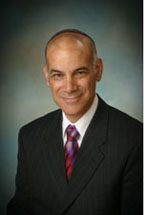 SAN DIEGO—Is it ever possible to study too much Torah? SAN DIEGO—Is it ever possible to study too much Torah?
Rabbi Elimelech of Lizensk once went to Nicholsberg to visit the sage Rabbi Shmilke. On Shabbat he took a walk and heard a man’s voice coming from a nearby house. The man was studying Torah. He read the text out loud and discussed it with himself with great enthusiasm. The door was open so Rabbi Elimelech entered and saw Rabbi Mordechai Bendt hunched over the table immersed in several open texts.
Rabbi Elimelech stood in the doorway for an hour. Rabbi Bendt never looked up from his books nor indicated in any way that he knew Rabbi Elimelech was there. When Rabbi Bendt finally glanced up Rabbi Elimelech approached him and said: “My brother, you must do Teshuva (repentance) and return to your Creator, blessed be God!”
Rabbi Bendt was crestfallen and speechless. He did not understand the rebuke. He also knew that Rabbi Elimelech was Rabbi Shmilke’s friend, and that Rabbi Shmilke admired and respected him.
Rabbi Bendt went to see Rabbi Shmilke and told him what had happened. He told him that he did not understand what his sin might have been since all the time that Rabbi Elimelech was in his home the only thing he did was study Torah.
Rabbi Shmilke answered him. “Because you were so focused on the text that you did not even see him enter,” he explained, “Rabbi Elimelech realized that you were probably neglecting to eat and to take care of your physical health. Studying Torah is holy and sacred. But if you neglect your health and become ill you will not be able to study Torah at all! You must not fail to attend to the necessities of life and care for the world in which we live even for the sake of Torah study!” (Chassidic Stories, Rabbi Shlomo Yosef Zoin, p. 354)
I do not think that Rabbi Elimelech would have thought of it in these terms, but what he seems to be cautioning Rabbi Bendt against was obsessive behavior. Even something as noble and praiseworthy as Torah study can become a destructive if you fixate on it to the exclusion of everything else. When you obsess over anything and ignore your own well-being and the needs of those around you, you run the risk of harming yourself and those you love physically and emotionally.
What applies to Torah study applies even more so to less worthy causes. All of us need to be wary of any behaviors, be they at home or at work, be they positive or negative, which threaten to remove us from life’s realities, our own needs, and the needs of our loved ones and society. The well rounded human being lives in this world not apart from it.


AMAZING STORIES OF JUDAISM
Trusting in Hashem at Bear Stearns
By Rabbi Baruch Lederman
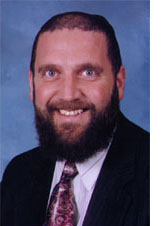 SAN DIEGO—On Shavuous, we accept the Torah and Mitzvos, as the Children of Israel did on Mount Sinai, and as Rus (Ruth) did in the days of old. Torah and Mitzvos have retained their newness and excitement, as well as their deep meaning to this day, as is illustrated by the following true account written by Robert Savit of Bear Stearns, in the aftermath of the 2008 subprime mortgage collapse. SAN DIEGO—On Shavuous, we accept the Torah and Mitzvos, as the Children of Israel did on Mount Sinai, and as Rus (Ruth) did in the days of old. Torah and Mitzvos have retained their newness and excitement, as well as their deep meaning to this day, as is illustrated by the following true account written by Robert Savit of Bear Stearns, in the aftermath of the 2008 subprime mortgage collapse.
To the Bear Stearns Minyan, one last time:
After two great years at the Bear, and having been observant for about the same amount of time, I have chosen to immerse myself in learning at Ohr Somayach Yeshiva in Eretz Yisroel.
The Bear mincha minyan was really my first regular minyan and it provided me with much inspiration. The whole concept was foreign to me. The idea that a few dozen men at a major financial institution would take time out of their busy schedules and express their gratitude to Hashem, in a conference room within the building no less, was a big motivator for me. Moreover, nobody was talking, rarely were there any cell phone interruptions, and some were even able to achieve serious kavanah. Thank you to everyone who davened for inspiring me with your tefillah.
While I sympathize with those who lost money and jobs, we know that everything happens for a reason and it will all work out for the best. That being said, the collapse of BSC provided a great deal of mussar to all who wish to see it. There are some employees who gave their heart and soul to the company for many years, and some lost thousands or even millions of dollars (Jimmy literally lost a billion!) - they learned the hard way that money is fleeting. Still there are others who were with the company for only a few months who will receive a nice severance package and have already accepted offers elsewhere at higher salaries. There are those, who because of the extraordinary amount of time that they spent at the office, missed out on many milestones (birthdays, weddings, etc.), and lost it all. And there are those who were just in the right place at the right time. And of course there are stories of everything in between. There are no accidents.
Hashem is in charge of the world. Sometimes when we are in certain situations it is difficult to have a clear perspective. In the business world it is so easy to get caught up in the day to day and to lose sight of what really matters This experience has truly served to clarify for me the idea that the only "things" that are timeless are the mitzvahs that we do and the tzedakah that we give in this world. Bear Stearns will soon be a distant memory but hopefully this lesson will remain with us.
There was once a man traveling through Europe in the 1800's. He came to the town where the Chofetz Chaim had lived. The traveler stopped in to meet the great Talmid Chuchum. When he arrived at the house, he saw that the Chofetz Chaim lived in a tiny home. He knocked on the door and when he looked inside he saw a nearly empty one-bedroom apartment. The traveler asked the Chofetz Chaim, "aren't you the great Chofetz Chaim? How can you live likethis? Where are all of your possessions?" The Chofetz Chaim turned to the traveler and posed the same question. "Where are all of your possessions? All you have with you is a suitcase." The traveler answered, "Well, I am just passing through," to which the Chofetz Chaim responded, "I too am just passing through."
As I have been inspired by everyone at the minyan, and certainly affected by the events that have
transpired at Bear, I hope that you are all inspired by the messages that Hashem sends us on a daily basis and that you continue to strive to achieve a true closeness to the Rabbeinu shel Olam.
Nachum and I had a brief conversation with our CEO, Alan Schwartz, in the elevator on the way to Mincha yesterday. We invited him to daven with us though we conveyed our feelings that maybe our prayers for the well-being of Bear Stearns had not been received in the way that a lot of people had hoped. He had a meeting to attend but he left us with some great mussar.
He said something along the lines of 'don't worry fellas - your prayers are being answered - we just don't know how.' Now I don't know if he has been meeting with a Rabbi over the past few months or if it was just the power of the pintele Yid but I thought it was a great attitude reflecting on what has no doubt been the most tragic part of his career. Hashem sends us messages all the time and from the most unexpected places.
Dedicated by Dr. Gersham & Chavi Stein & Family.


JEWISH GREEN
Green collective for Jewish institutions?
By Marissa Palin
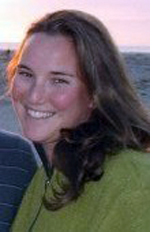 SAN DIEGO—Did you know Emperor Penguins can only be found in three places in the world? Aside from Antarctica and Japan, the United States is the only other country to be blessed with such a rare species. And they’re here - right here in San Diego. As I was listening to my mother recount this information after her recent visit to SeaWorld, I flashed back to all my recent failed attempts at finding green Jews in San Diego. How was it that our city was honored with such a rare breed of birds, yet I couldn’t seem to find a green Jew? They must be out there somewhere—but where? Were they all congregated together in some place I hadn’t discovered yet? Was I just not looking hard enough or were they actually as rare as Emperor Penguins? SAN DIEGO—Did you know Emperor Penguins can only be found in three places in the world? Aside from Antarctica and Japan, the United States is the only other country to be blessed with such a rare species. And they’re here - right here in San Diego. As I was listening to my mother recount this information after her recent visit to SeaWorld, I flashed back to all my recent failed attempts at finding green Jews in San Diego. How was it that our city was honored with such a rare breed of birds, yet I couldn’t seem to find a green Jew? They must be out there somewhere—but where? Were they all congregated together in some place I hadn’t discovered yet? Was I just not looking hard enough or were they actually as rare as Emperor Penguins?
And then Ethan Lipman contacted me. Ethan Lipman, Solar Design Engineer at Borrego Solar. With a degree in Mechanical Engineering from UC Davis, Ethan came to San Diego more than two years ago and began working for Borrego Solar. In true green spirit, he spends his days turning dreams into reality. “When someone decides they are going to put solar panels on their roof,” he said, “I am the one who turns the project into a constructible item.”
But it got better. Not only had Ethan dedicated his professional life to being green, but then he dropped the golden words: Jewish Facilities Solar Initiatives (JFSI). Ethan volunteers his time for JFSI, an organization dedicated to bringing clean and renewable solar energy to Jewish facilities at prices competitive with current energy costs. This was it! This was my pot of gold at the end of the rainbow—a Jewish green volunteer and a local Jewish green organization, all in one.
JFSI wasn’t originally local. It was started by two guys (in addition to their day jobs), one who lives in San Francisco and the other who lives in Santa Barbara. But now with Ethan on board, JFSI has a San Diego correspondent. His involvement includes finding Jewish organizations in San Diego interested in signing with JFSI and using solar energy.
Switching to solar energy can be a daunting task. With outrageous capital costs and extensive operation and maintenance demands, installing solar panels is nearly impossible for most Jewish agencies. But JFSI’s goal is to make it easy for Jewish agencies to switch to solar energy, with little to no operational or financial impact on the agency.
They’re aiming to identify 1.5 Megawatts worth of interested Jewish facilities (about 15-25 facilities) before implementing the project. Once implemented, the project is eligible for a 30% federal tax credit, which, along with independent investors and funders, make the project possible. However, time is running out; the tax credit expires at the end of the year. So unless Congress extends the credit, JFSI is under a serious time crunch to identify enough host facilities.
To be eligible, interested agencies must first meet a certain criteria (listed at www.jfsi.org) and then enter a Power Purchase Covenant (PPC) with JFSI. The PPC, (known in the secular world as a Power Purchase Agreement), sets the guidelines JFSI agrees to follow in selling solar energy to an agency, and determines the exact monthly rate an agency will pay JFSI for years into the future, allowing agencies to budget accordingly. As long as current utility rates continue to rise at the rate they have been, locking-in to a set price through a PPC is guaranteed to increase an agency’s savings.
Once enough agencies have entered a Power Purchase Covenant, JFSI will set out to install an individualized solar power system for each agency. Agencies will purchase the energy generated from JFSI, paying monthly installments at rates comparable to current energy rates. JFSI will in turn repay investors, thus bringing the project full circle.
So the million dollar question: why should a Jewish agency go solar? Well my friend, the real question to be asked is why shouldn’t a Jewish agency go solar? Being environmentally friendly is deeply embedded in the Jewish value of Tikkun Olam, or repairing the world. It is our duty as Jews to protect and cherish the world we live in. Using solar energy does just that—and hopefully now with JFSI, the transition can be an easy one.
I challenge your congregations and organizations this coming fiscal year: consider going solar, either with or without JFSI. But in the very least, check out the JFSI website and see what they can do for your agency.
While you’re doing that, my hunt for green Jews and organizations continues. Although Ethan and I steered far clear of SeaWorld’s famous Emperor Penguins, I was excited to realize both rare breeds exist—green Jews are thankfully not as rare as the exceptional penguin.
For more information about Jewish Facilities Solar Initiatives, visit www.jfsi.org. If you know about green Jews and Jewish green events in San Diego,please contact me at the email below.
 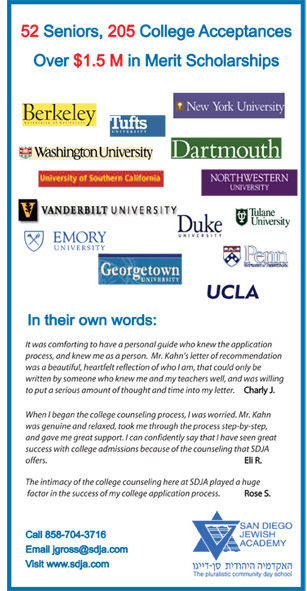

L.A. BEAT
The Schwartzes within The Brady Bunch
By Cynthia Citron
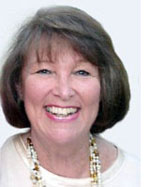 HOLLYWOOD, California—In the same year as the legendary Woodstock Festival, a TV show called The Brady Bunch began mesmerizing the children of the Age of Aquarius. That was 1969, and even though the TV show ran for only five seasons, its 117 episodes have appeared in reruns somewhere in the world every single day since 1975. HOLLYWOOD, California—In the same year as the legendary Woodstock Festival, a TV show called The Brady Bunch began mesmerizing the children of the Age of Aquarius. That was 1969, and even though the TV show ran for only five seasons, its 117 episodes have appeared in reruns somewhere in the world every single day since 1975.
Brady bunch, say hello to the Schwartz squad!
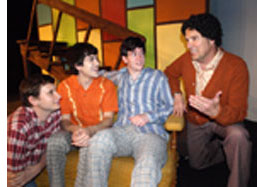 Sherwood Schwartz, who created The Brady Bunch (as well as that other cult favorite, Gilligan’s Island) was on hand at Theatre West in Hollywood on June 6 to watch his son, his son’s wife, his daughter, his daughter’s husband, and his grandson celebrate the Bradys in a brand new medium: an over-the-top theatrical adventure A Very Brady Musical. Sherwood is serving as Executive Producer. Son Lloyd J. Schwartz and his sister, Hope Juber, wrote the play, which Lloyd is directing, and Hope and her husband Laurence Juber wrote the music and lyrics. Lloyd’s wife, Barbara Mallory, plays the Mom, Carol Brady (the part immortalized by Florence Henderson on TV). Barbara is also the Associate Producer. And Elliot Kevin Schwartz, their son, plays the oldest Brady sibling, Greg. Sherwood Schwartz, who created The Brady Bunch (as well as that other cult favorite, Gilligan’s Island) was on hand at Theatre West in Hollywood on June 6 to watch his son, his son’s wife, his daughter, his daughter’s husband, and his grandson celebrate the Bradys in a brand new medium: an over-the-top theatrical adventure A Very Brady Musical. Sherwood is serving as Executive Producer. Son Lloyd J. Schwartz and his sister, Hope Juber, wrote the play, which Lloyd is directing, and Hope and her husband Laurence Juber wrote the music and lyrics. Lloyd’s wife, Barbara Mallory, plays the Mom, Carol Brady (the part immortalized by Florence Henderson on TV). Barbara is also the Associate Producer. And Elliot Kevin Schwartz, their son, plays the oldest Brady sibling, Greg.
The rest of the Bradys aren’t Schwartzes, though. John Cygan plays the dad, Mike Brady, and the rest of the “bunch” consists of Justin Meloni as Peter, Adam Conger as Bobby, Erin Holt as Marcia, Laura Marion as Jan, and Kelly Stables as Cindy. And rounding out the household is Kathy Garrick as Alice, housekeeper and major solver of problems. In the Matthew Hoffman photo above, the cast from left includes Adam Conger, Justin Meloni, Elliot Kevin Schwartz andJohn Cygan.
As might be expected, it’s a super-silly plot, which everyone overplays to the hilt with overwrought sighs and rolling eyes. A major theme is that Mom and Dad, married for three years, apparently haven’t been able to have any sex because they can’t ever steal a moment alone. Which prompts Mom to vamp her way through a delightfully explicit song, “Euphemisms,” with such lyrics as “You be my pickle, I’ll be your jar…”
Another theme is expressed in Alice’s song, “My Special Recipe,” in which she encourages the Brady kids with the lyrics, “A cup of confidence, a sprinkle of hope, a dash of experience will help you to cope.” What the kids are trying to cope with is an overheard play reading by their parents. The play is called I Hate Your Guts! and the scene the kids have overheard leads them to believe that their parents are on the verge of divorce. So, to acquire enough money to send their parents to a marriage counselor, the kids embark on a series of money-making schemes that land all six of them in jail.
Peter’s scheme is to become a magician, and he enlists Jan as his assistant. On opening night, however, when Jan called for a volunteer from the audience to come up to be sawed in half, she was expecting Roger Cruz, a cast member, to come onstage. But, much to the audience’s delight, an adorable little girl in the front row nearly jumped out of her seat to volunteer. Cruz must have wondered why his entrance got such a big laugh.
The various plot-lines, however, are merely vehicles upon which to hang the songs. And the songs are sweet and funny and satisfying. Unexpected rhymes, singable melodies, and a few exceptionally fine voices. Plus snappy choreography created by Paul Denniston, especially in the introductory song, “Groovy Happy Sunshiny Day.” It’s also fun to hear the Brady Bunch theme song again and to join the cast in singing it at the curtain call.
In addition to the family members, the cast includes characters who appear in the various subplots. Roger Cruz plays a gypsy hippie, a bank robber, the volunteer for Peter’s magic act, and a hilarious Mexican-accented judge. Mary Garripoli is bouncy as Trixie and Mrs. Fananigan. Matthew Hoffman plays a bank robber, an undercover cop, and a marshal. And Selah Victor is a sexy Destiny, a bursting Bubbles, and an authoritative police officer.
All this action takes place on a nearly empty stage. But set designers Daniel Keough and Joseph Altadonna have constructed a large panel that opens, unfolds, or rotates to become an inside wall and staircase of the Brady house, the town’s Main Street, with all its colorful shops, a Swap Meet, where the parents, Carol and Mike, first met, and an Escort Service, which is featured in one of the subplots.
A Very Brady Musical is a loving tribute to a very specific time in our collective history. And over 40 years the original TV show has spanned the generations, each of which has recognized it as the cult classic it has become. So come and enjoy the musical. And bring your kids. And grandkids.
The world premiere of A Very Brady Musical will continue at Theatre West, 3333 Cahuenga Boulevard West, in Hollywood, Fridays and Saturdays at 8 p.m. and Sundays at 2 through July 20th. Call (323) 851-7977 for reservations.


 
THE JEWISH CITIZEN
Sports theme at San Diego County Fair
By Donald H. Harrison
 DEL MAR, California—Although telling you this gives away an answer to one of columnist Evelyn Kooperman’s San Diego Jewish Trivia questions (her column runs here on Wednesdays) the large sculpture of the discus thrower situated at the front of the Del Mar Fairgrounds was commissioned by Bob Breitbard, a Jewish community member and founder of the San Diego Hall of Champions in Balboa Park. DEL MAR, California—Although telling you this gives away an answer to one of columnist Evelyn Kooperman’s San Diego Jewish Trivia questions (her column runs here on Wednesdays) the large sculpture of the discus thrower situated at the front of the Del Mar Fairgrounds was commissioned by Bob Breitbard, a Jewish community member and founder of the San Diego Hall of Champions in Balboa Park.
Normally situated in the museum’s rotunda, the 7 ½ foot high sculpture by I. Andrea (formerly known as Andrea Hoffman) rotates on a pedestal to announce the theme of this years’ San Diego County Fair: The Summer of Sports.
In her books, San Diego Trivia and San Diego Trivia II published respectively in 1989 and 1993, Kooperman passes on little known facts about familiar San Diego people and places. The model for the sculpture was an SDSU student, Stan Vegas. Sculptor Hoffman has other examples of public art in San Diego. She did the bust of the Jewish philanthropist Mandell Weiss at La Jolla Playhouse and the statue of the Catholic saint, Our Lady of Guadalupe, on the University of San Diego campus.
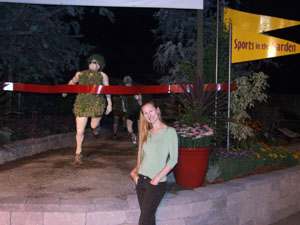 
A little beyond the entrance, down a passageway to the left, are several acres of temporary landscaping, including a featured exhibit by artist Michelle Dougherty of Escondido showing marathon runners nearing a finish line, again in keeping with the Summer of Sports theme. The sculptures are similar to topiary in concept, meaning that as environmentally friendly decorations they may be transferred from, say, a bar mitzvah reception to the backyard of a home.
“Another Jewish angle for you!” commented Marsha Sutton of the Carmel Valley News, who with her husband Rocky Smolin was among the hundreds of journalists and media representatives at a Friday night media preview of the June 14-July 6 San Diego County Fair.
Dougherty told us that she actually is new to landscaping but as an artist enjoyed the opportunity of working in the natural colors of flowers. “You really can tell she has an art background,” commented Dan Cannou, manager of the flower and garden show. “Just look at the color balance.”
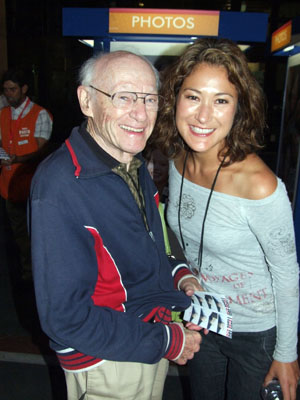 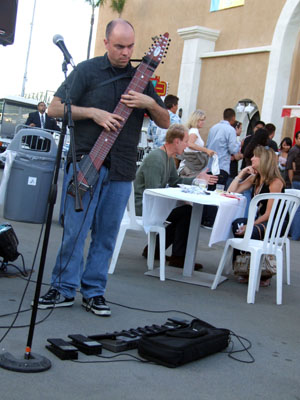
There was much to be seen—and too much to be eaten—along the midway and pedestrian thoroughfares crossing it. My wife Nancy and I toured with her father, Sam Zeiden, 89, stopping at one point at a photo booth that permits you to pose for four snapshots. While you are posing—or setting up for the pose—you can be seen by passersby on a video screen. When dad sat alone in the booth, Jenny Hamel, a reporter and weekend anchor with XETV, Channel 6 , decided on the spur of the moment to give him a little surprise. So on Shot Two, she popped into the booth and gave him a kiss on his cheek! Boy, did he smile!
There were numerous entertainers along the midway, but the one whose musical instrument I found the most interesting was Tom Griesgraber, who was playing a Chapman Stick—which looks like the neck of an electric guitar without the body. The melody Griesgraber was playing had a Middle Eastern quality to it—which seemed perfect musical accompaniment to the chicken kabob, hummus and tabuli dinner combination that we sampled from Chicken Charlie’s.
We sat with Gerry and Marilyn Greber while listening to the Chapman Stick. In addition to writing for San Diego Jewish World, Greber sometimes volunteers as a docent at the Museum of Making Music in Carlsbad. I asked Griesgraber if he was familiar with the museum, and he said that his mother was a great supporter of it. In fact, he said, a Chapman Stick that he once had played I now part of its collection.
 
There was a Rube Goldberg-sort of game along the midway that Nancy and her dad both tried. Press a button to eject a stream of water which you aim at a control which releases air into balloons. The first competitor who can turn the pressure of his or her thumb into water pressure into air pressure to produce a balloon explosion wins! “You’d need a lot more intermediate steps for that to be a Rube Goldberg!” commented my father-in—law, a retired engineer who remembers the inventors’ crazy drawings quite well. Okay, so maybe it was a Whoopi Goldberg.
At a dairy and yogurt booth, where we chatted in line with San Diego Jewish World writers Joel and Arlene Moskowitz, Nancy ordered up a concoction nicknamed the “cow” a soft-serve ice cream cxoncoction served on a waffle base and garnished with chocolate sauce and cookies. As the counter man got ready to serve her, he joked that people purchasing it are supposed to “Moo.” Having grandchildren to whom she has on more than one occasion sung “Old McDonald,” Nancy promptly complied.
I didn’t hear any other moos, but I thought I heard a soft baa-ah, and an occasional gobble, gobble. Among the animals mingling with the crowd were a pair of Nubian goats—Sadie and Lupe—raised by Ariel Bieweg and her mother, Dana, on the grounds of their Encinitas home. The goats will be entered in a competition and judged on their lines and bearing, Ariel told me. As they were raised by humans—even to the extent of being bottle fed—the goats are very comfortable with people coming up to touch them.
The turkeys were part of the Turkey Stampede, turkeys that race several times a day after a battery-operated feed wagon, providing much amusement to fair goers. Nearby, a food stand offers barbecued turkey legs, making me wonder if that provided extra incentive for the gobblers to run quickly.


SDJA STUDENT QUARTERLY
Editor's Note: The following three stories are reprinted from the current issue of SDJA Student Quarterly, the student publication of San Diego Jewih Academy. San Diego Jewish World editor Donald H. Harrison serves as a journalism teacher and newspaper advisor at San Diego Jewish Academy.
Seniors leave big shoes for juniors to fill
By Gaby Maio
Walking around the SDJA, the seniors couldn't help but be noticed. Phrases such as, "Nothing gold can stay," and "The world will come to an end," were often heard when speaking of the seniors' departure from high school and towards college for a new life.
April 16th was the seniors' last day of classes and implanted in all juniors' minds as the day of tears and hugs goodbye. Second semester seniors roamed around campus with confidence holding their overachieving 4.0s in one hand and a long impressive list of college acceptances in the other. Known as one of the most ambitious SDJA graduating classes, with each senior having individual motives and passions, the Class of 2008 spent memorable and worthwhile years at our school.
For the past four years, the class of '08 was the largest group in the school, and its 53 members were part of the biggest graduating class that the SDJA has yet to see.
Brian Kissell, Dean of Student Affairs of the Upper School, had extremely close ties to the graduating class due to the fact that it was the first group of students that he had taught as a teacher here at the JA. During their school careers, Kissell has taught each senior at least once and others multiple times. Watching them move to become, no doubt, successful makes him proud and he admits that they will definitely be missed here on campus.
The past few months were spent in anticipation of receiving the golden envelope in the mail declaring the seniors' acceptances to college. All of the work put into the last four years of high school has finally paid off.
Colleges that sent acceptance letters to SDJA seniors included Georgetown, Penn, University of Michigan, Brown, Syracuse, UCLA, UCSB, Berkeley, Duke, University of Arizona, Emory, NYU and USC. Getting accepted, however, did not settle the matter; many students who received multiple acceptances then had to decide where they really wanted to go.
In some cases mere seconds before boarding the plane for their senior trip to Poland and Israel, the seniors sent in their deposits to the college, assuring their places in the entering freshman classes.
Being a senior at the Jewish Academy has quite the advantage: finishing classwork a month and a half early in order to travel and learn in Europe and Israel. The seniors left regular classwork behind the day before spring break. During the break, many seniors ran around San Diego buying t-shirts, sweat shirts, and hiking shoes. Yet unlike the juniors and other class members who came back to school April 28, the seniors ran to the airport. With each piece of luggage required to be under (gasp!) fifty pounds, some had more trouble than others. Yet they all managed to take off for Poland and Israel for the five-week adventure.
When asked about their major accomplishments in high school, members of the Class of '08 cited a range of activities and experiences. For Meredith Kaplan, it was receiving a scholarship to Sarah Lawrence and challenging herself academically. For Rose Sheela and Jordan Dubin, it was dominating in the SDJA's first-ever Powder Puff Football, and for Elan Frank, it was coaching them to victory. Gabriel Magun said his major accomplishment was creating the Business Club while Michael Landau spoke proudly of becoming captain of the varsity baseball team.
Favorite memories from Seniors '08 include the Yom Ha'Atzma'ut iFest '07; the Pumpkin Drop Lab, class trips, ninth-grade Hebrew classes, yearbook and precious moments with Bruce Tashoff {science teacher}. Yet there is more to the senior class than just memories and events shared together. Their classmates mean just as much to them.
In response to a written questionnaire, numerous seniors complimented Zuri Michan, saying that he is one of the nicest human beings, that he has an incredible heart, and is extremely smart and hardworking.
Ben Schenk was also highlighted by his peers for losing weight and for 'bringing it back to the 212,' and for being an overall funny person and great leader. Eli Recht was said to be extremely helpful, nice to everyone, and an overall well-rounded individual. Alex Stone was highlighted for being part of the dream team; Rose Sheela for her sarcasm; Micah Klareich for his luscious locks, and Michael Landau for being disciplined, hardworking, smart and funny. Matt Turner was also said to be an outstanding member of the senior class for his humor and capability to make anyone laugh.
For the years to come, there is no doubt that this unique student class will remain close and stay connected. After building a family-like community for so many years, the long distance between them when they are off to college is bound not to hurt them. Home for vacations, planned visits, and staying in touch through phone calls and internet, this senior class of '08 will say as strong as ever. They have spent four wonderful years here at the academy and the fact that they will all be off to college this fall and onto new lives does not diminish the memories they have created and the friendships that have grown.
Looking ahead, in the years to come, these students are likely to become extremely successful and even more ambitious than they already are now. They have lived up to, and put meaning to the phrase, "Nothing gold can stay." Those of us remaining at SDJA wish them luck for their future. We all anticipate that they will succeed, flourish and create change in this world one by one.
Pickets target SDJA
By Eitan Frysh
Recently pickets have been protesting outside the San Diego Jewish Academy and La Jolla Country Day School with similarly worded, startling banners proclaiming "Shame On" each of the schools.
The protests are aimed at use of non-union workers in major construction projects. In the case of San Diego Jewish Academy, the controversy focuses on the laborers building the new gym. Did the school intentionally hire non-union workers for cheaper labor, and is this wrong?
"The particulars of this situation are that the school hired a contractor that then licensed and bonded their contractors. By all means that have the right to do whatever they want, and what they chose to do was hire a non-union contractor," stated picket leader Eon Law.
"We're not particularly fond of that idea because we feel that any contractor in this area should be using union labor because we feel that everyone should be getting a fair amount of wages," Law added. "My dispute at this moment is that the school should pay more attention to what it's signing. The school should have a good fostering for its union workers instead of using non-union workers."
Larry Acheatel, executive director of the San Diego Jewish Academy, responded: "San Diego Jewish Academy does not employ the subcontractors, but hires a general contractor to build the gym. The general contractor then goes out and hires various subcontractors to complete various stages of the project. The 'general' has, in fact, hired some companies that are not union companies. We did not require the general to hire only union companies. ... Public schools are required to hire only union companies or pay union level wages. Private schools, businesses, etc., are not required to do this."
Furthermore, said Acheatel: "The gymnasium, like all of our other facilities, has been built with philanthropic donations. No tax revenues are received to help with this cost. All of our decisions regarding this project have been very cognizant of keeping the costs to the minimum without impacting health, safety, programming, etc. Therefore, all work has received two to three bids from various companies and the general contractor has almost always taken the lowest bid.
Efforts were unsuccessful to reach La Jolla Country Day administrators for comment.
New programs in SDJA ASBC
By Shiri Bogomolny
The ASBC officers file into the small ASB room, yellow folders in hand, and sit around the long wooden table in the center of the room. With a pen suspended in between the thumb and index finger of the right hand, and a notebook in her left hand, the secretary sits across from me, ready to begin writing. I grab onto the tape dispenser we use as a gavel and begin banging it on the table: "Order, order!" I exclaim as the group begins to quiet down. "Order!" I repeat once more as the last whispering conversations come to an end.
But even though people do quiet down, there cannot be much order; that is because there is so much to do. Half-an-hour-long lunch meetings aren't enough, and even if we were to meet twice a week or even every day at lunch, that still would not give us enough time to get through everything we need to get to. Additionally, nature dictates that fifteen high school kids locked in a small cage-like room with a glass wall cannot remain in "order" for too long!
It is from such experiences week after week that the idea for a more productive ASB with smoother-flowing meetings came about; thus came the birth of the cabinet system. Formulation for this significant undertaking took several long nights of little sleep and long phone conversations. Eventually, we had drafted a proposition to be presented to the admin, and one to be presented to the students. The goal of the cabinet system is to reduce the number of people on the core ASB so our meetings can run smoother and be less chaotic, but to increase the opportunity for people to participate in leadership of our school.
The cabinet system is based on five committees run by a cabinet commissioner. The cabinet positions are: Public Relations, Athletics, Dances, Seniors, and Student Affairs. the cabinet commissioners are appointed by the ASB by an application process, and together with the ASB cabinet heads can select their committees.
Some students were quick to point out that the selection system would be problematic because that would lead certain individuals who are closer friends with members of the ASB to be favored over others; thus, we have created a rubric system so that the selection of applicants can be as objective as possible. Additionally, this system of appointing is used by several other schools and we will constantly be seeking advice from members of other schools' ASBs to keep our ASB running as well as it can.
The reason we are doing this is because a year of hard work and experience have shown us that there are certain changes that will make the ASB run much more smoothly. Our only goal is to touch up on the loose ends of the system so that the ASBC can turn into a strong representative body that will stand up for the students and give them what they want. We have begun with off-campus lunch for seniors. With a better system...imagine what more can be achieved!
Core ASB meetings will be held on a weekly basis, and general ASB/ASBC meetings will be held every month with all the commissioners of all cabinets and the core ASB (core ASB includes President, V.P., Secretary/Treasurer, grade representatives and Special Events Chair). Individual committees will meet on an as-needed basis.
The ASB motto this year was "Nothing is Impossible," using the double negative to imply that the only thing that can get in the way of our success is our own lack of dedication or motivation.
Our year of success included obtaining off-campus lunch privileges for seniors, planning a never-before seen lunch activity with a cotton candy machine, a bounce house, and a Velcro wall, and the pioneering of a powder puff football tradition.
I would like to end by thanking you for all your year of support. Thanks to you we have been able to take our school to new heights and institute new programs that have never been done before! As your student representativ es we always have you in mind as we work together with the administration to improve our experience here at the SDJA. We promise to continue working hard and hope to continue to be the voice of the students in the future.


ADVENTURES IN SAN DIEGO JEWISH HISTORY
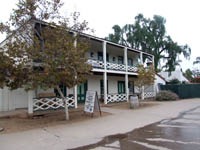
Robinson-Rose House
|
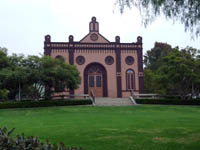
Old Temple Beth Israel |

Lawrence Family JCC |
Editor's Note: We are reprinting news articles that appeared in back issues of various San Diego Jewish newspapers. You may access an index of the headlines of those articles by clicking here. You may also use the Google search program on our home page or on the headline index page to search for keywords or names.
Western States Meet; Here This Week-End
From Southwestern Jewish Press, March 6, 1947, pages 1, 3
Jewish Communal leaders from 12 Western States and Western Canada will meet in San Diego at the U.S. Grant Hotel on March 7-9-10 to discuss problems pertaining to fund raising, the overseas problem as related to Jewish needs; community relations, and civic protective work.
Leaders and members of the San Diego community will have an opportunity to attend, participate in these sessions and hear outstanding national speakers well versed in their respective fields.
A number of San Diegans will take part in the discussions outlined in the various programs during the three-day sessions. The results of the Conference will undoubtedly be noticed during the coming year in the work of the agencies affiliated with the Council of Jewish Federations and Welfare Funds.
Henry Epstein to Address Community Relations Session
The Regional assembly session on community relations will have Henry Epstein, chairman of the National Community Relations Advisory Council of New York City, as the principal speaker. Mr. Epstein was Solicitor General for New York State during the years 1932 to 1942, he was Counsel to the President’s Fair Employment Practices Committee in 1943; Counsel to the Emergency Relief Administration in New York State from 1931 to 1932. In addition to being Chairman of the National Community Relations Advisory Council, Mr. Epstein is currently chairman of the Commission of Community Interrelations of the American Jewish Congress and Trustee of the Jewish Institute of Religion.
The National Community Relations Advisory Council {NCRAC}is the national agency concerned with coordinating local civic protective activities. It was created in 1944 as the result of activities initiated at the CJFWF {Council of Jewish Federations and Welfare Funds} General Assembly. The NCRAC consists of representatives from the Jewish Labor Committee, B’nai B’rith Anti-Defamation League, the American Jewish Committee, the American Jewish Congress, Jewish War Veterans, Union of American Hebrew congregations and local community relations councils in 21 cities in the Western States Region. These include the Oakland Public Relations Council, the San Francisco Survey and B’nai B’rith Community Committee and the Los Angeles Community Committee of the Jewish Community Council.
Mr. Epstein who is known as an outstanding speaker will review the national picture in civic protective work and will present a guidepost for the development of local services.
Overseas Session to Hear Bartley Crum
The Sunday evening, March 9 meeting of the Regional Assembly will be devoted to a presentation of the overseas problem as it relates to Jewish needs. Chief speaker will be the Honorable Bartley C. Crum of San Francisco, former member of the Anglo-American Commission of Inquiry on Palestine. Mr. Crum, a noted San Francisco attorney, was one of six American representatives on this commission which unanimously recommended the immediate entrance of 100,000 Jewish DPs into Palestine. As part of the commission’s work, Dr. Crum spent a number of months in Europe and Palestine last year and has intimate knowledge of the total European and Palestine picture. A book based upon his experiences will be published shortly.
Mr. Joseph E. Beck, Executive Director of the United Service for New Americans, New York City, will also appear on the program. The United Service for New Americans represents a merger of the National Refugee Service and the Section on Foreign-Born of the Council of Jewish Women. As a member agency of the United Jewish Appeal, the U.S.N.A. is responsible for administering the vast refugee resettlement program in this country. Mr. Beck speaks on the basis of broad experience and understanding of this significant problem.
Fund Raising Session To Analyze 1947 Needs
“Financing Jewish Needs in 1947” is the subject of the Monday afternoon, March 10, session. It will consist of three concurrent meetings devoted to welfare and capital fund raising, women’s divisions, and youth and young adult division.
Reflecting the increased interest in women’s and young people’s activities, representatives from these two groups will lead and participate in their own sessions. Mrs. Hal Horne, Chairman of the Women’s Division of the New York United Jewish Appeal, will serve as moderator for thewomen’s division session, with Mrs. Abraham Nasatir of this city and Mrs. Bert Allenberg, Chairman of the Los Angeles United Jewish Welfare Fund’s Women’s Division, as discussants.
Miss Hadarah Domnitz of San Diego will chair the young people’s session, with John Steinhart of San Francisco and Carl Goldman of Long Beach as discussants.
Charles Brown, President of the Los Angeles Jewish Community Council, will moderate the welfare fund session, with Ike Sukman of Long Beach, Walter D. Heller of San Francisco, and Al Shyman of Seattle as discussants.
Council Services Discussed by Associate Executive Director
Philip Bernstein , Associate Executive Director of the Council of Jewish Federations and Welfare Funds whose offices are maintained in New York City, will be the principal speaker at the Sunday, March 9, luncheon of the Regional Assembly, San Diego. Mr. Bernstein will speak on the subject “The Council and the American Jewish Community.” Mr. Bernstein was raised to his present position by action of the CJFWF General Assembly held in Atlantic City last month. He formerly held the position of Director of Field Service.
The CJFWF now is composed of 280 member welfare funds, federations and community councils in 260 cities throughout the United States and Canada and serves almost 800 communities through each of these organizations, all groups and elements in the community working together to meet the major responsibilities of American Jewry. Through the CJFWF the communities express their cooperation on a national level.
Mr. Stanley C. Myers of Miami, Floria, is national president, and H.L. Lurie, Executive Director. Max H. Block of Seattle and Morton J. Gaba of San Francisco serve as regional president and director respectively.
Beth Jacob to Have New Rabbi
From Southwestern Jewish Press, March 6, 1947, page 4
Rabbi Abraham L. Rosenblum, formerly of Salt Lake City has accepted the post of spiritual leader of the Beth Jacob Congregation. Rabbi Rosenblum, who received his education in Europe, Palestine and the United States, will take his position on March 15th. Rabbi Rosenblum who is well versed in Polish, German, Italian and Hebrew as well as English and Yiddish, earned his A.B. and M.A. degrees at the Indiana State Teachers College. He is married and the father of two children.
Rabbi Rosenblum will conduct his first service Saturday morning, March 15th, at the Beth Jacob Shule, 3206 Myrtle Street. Members and friends are invited to participate.
Wins Akiba Award
From Southwestern Jewish Press, March 27, 1947, page 5
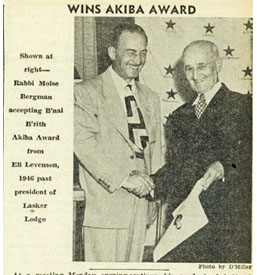 At a meeting Monday evening of Lasker Lodge B’ni B’rith, presentation of the “Akiba” Award for 1946 was made to Rabbi Moise Bergman, rabbi emeritus of Temple Beth Israel. Chosen by the Board of Directors of the Lodge for his outstanding contributions to B’nai B’rith and the general community during the year 1946, Rabbi Bergman was awarded the honor early in January. At that time, he was seriously ill and unable to receive the award. At a meeting Monday evening of Lasker Lodge B’ni B’rith, presentation of the “Akiba” Award for 1946 was made to Rabbi Moise Bergman, rabbi emeritus of Temple Beth Israel. Chosen by the Board of Directors of the Lodge for his outstanding contributions to B’nai B’rith and the general community during the year 1946, Rabbi Bergman was awarded the honor early in January. At that time, he was seriously ill and unable to receive the award.
In making the presentation, Eli Levenson, retiring president of the Lasker Lodge expressed the sentiment of the membership in stating how grateful B’nai B’rith is to have so outstanding a member as Rabbi Bergman. The Rabbi was quite touched by the honor, and opined that he would endeavor to continue his work in behalf of B’nai B’rith and the community. His friends join in congratulations to him upon his having been chosen for the “Akiba” Award and prays that he will be spared for many years to come to continue being the inspiration and model for the work that is to follow in the community.
{Return to top}

Nancy Harrison
cruise & tour specialist
(619) 265-0808

SAN DIEGO JEWISH WORLD THE WEEK IN REVIEW
Middle East
Weighing Obama and McCain from an Israeli perspective, each has drawbacks by Ira Sharkansky in Jerusalem
UK academic boycott of Israel resurfaces by Lloyd Levy in London
Canada
New Yorker brings California-style Jewish healing service to Anglophone Toronto by Rabbi Dow Marmur in Toronto
San Diego
Three commentaries from SDJA Student Quarterly, a student publication of San Diego Jewish Academy:
—Taking the SAT: The best four hours I ever spent trying to gouge out my eyes with a pen by Micah Frank
—CA court advances march to equality by Harry Doshay
—Iran's deadly bias against gays by Sarah Abelsohn
The Arts
Chapter Eleven of Reluctant Martyr, a serialized novel by Sheila Orysiek of San Diego
When octogenarian father and 40ish son both are single, who gives dating advice? Book review by Donald H. Harrison in San Diego
Programme Request? Take A Number by Carol Davis in San Diego
Adventures in San Diego Jewish History
—March 27, 1947: U.J.F. Off To Flying Start: San Diego Aware of Unprecedented Need in 1947—Geared to Meet It
—March 27, 1947: Editorial Page: Hope, Faith and Charity
—March 27, 1947: We were there by Albert Hutler
Middle East
The presumptive presidential candidates address the American Israel Public Affairs Committee on Israel and the Middle East:
—Barack Obama to AIPAC, June 4
—John McCain to AIPAC, June 2
—Clinton: Obama a good friend to Israel
Was that Condy Rice... or Sandy Berger? by Shoshana Bryen in Washington, D.C.
San Diego
Guardians' golf and tennis tournament a fitting Seacrest fitness-center fundraiser by Donald H. Harrison in Rancho Santa Fe, California
The Arts
Thursdays With The Songs of Hal Wingard
—Purely White
—Purely Black
—Together
Insiders File
—The people behind San Diego Jewish World
Adventures in San Diego Jewish History
—Palestine Capable of Absorbing 1,100,000 Says Nathan
—Palestinian To Speak Here on Tuesday
—We Were There by Albert Hutler
)
Middle East
Condoleezza Rice's stand over Gaza scholarships is counterproductive by Shoshana Bryen in Washington, D.C.
United States of America
Elections, conversions, award ceremonies: the shehecheyanu moments of springtime by Donald H. Harrison in San Diego
Australia-New Zealand
News Roundup by Garry Fabian:
—Twelve named to Jewish Community Council of Victoria board of patrons
—Remembering a fallen classmate
—Not just 'my son the doctor' these days
—Australian Jewish women on top of the world
—School funding safe despite fears
—Philanthropists make record donation to arts
—Camp KEF a success
—New Zealand marks Israel's 60th Anniversary
—Citizenship Test - Update
Lifestyles
Women are the subject of our local Jewish trivia quiz by Evelyn Kooperman
Adventures in San Diego Jewish History
—January 9, 1947: Kaufmans Feted On Departure
—January 9, 1947: Jewish Labor Committee by Ben Feinberg
—January 9, 1947: Pioneer Women's Organization
Middle East
Israel, at 60, has many kvelling points by Dorothea Shefer-Vanson in Mevasseret Zion, Israel
Syria's 10-meter problem at the Kinneret by J. Zel Lurie in Delray Beach, Florida
The Arts
Masterful retelling of Shoah in Vilna by Donald H. Harrison in San Diego
From Red Diaper Baby to Citizen Josh by Carol Davis in San Diego
Lifestyles
Are you lazy? You can put the blame on your genes—when you get around to it by Natasha Josefowitz in La Jolla
Adventures in San Diego Jewish History
—December 16, 1946: That's What I Think by Ray Solomon
—December 16, 1946: J.C.S.C. by Joe Wertheim
—January 9, 1947: Robt. R. Nathan-Wollheim To Speak Here Monday
Middle East
Ehud Olmert, does clock tick for thee? by Ira Sharkansky in Jerusalem
Jerusalem Day at Mercaz Harav Yeshiva by Judy Lash Balint in Jerusalem
Operation Homefront: Helping our American troops, no matter our politics by Rabbi Leonard Rosenthal in San Diego
The Arts
Zohan restyles Jewish comedy by Rabbi Simcha Weinstein in New York
A production you'll get a big bang out of by Carol Davis in Solana Beach, California
Lifestyles
Why the Bella Family Circle stopped its annual tradition of selling white elephants by Sheila Orysiek in San Diego
Adventures in San Diego Jewish History
—December 12, 1946: Bergen Belsen Director to Speak
—December 12, 1946: Black Book Now at Public Library
—December 12, 1946: Welcome Home...A Job Well Done
Middle East
Zbig's efforts to accommodate Iranian mullahs didn't work then; won't work now by Shoshana Bryen in Washington D.C.
Author asserts Palestinians' ancestors converted under pressure from Judaism by Donald H. Harrison in San Diego
Judaism
The Sinai and the modesty commandment by Rabbi Leonard Rosenthal in San Diego
Yes, she was Jewish, but she had to ask her father what Yom Kippur was all about by Rabbi Baruch Lederman in San Diego
The Arts
'La Jolla North' at the Statford Festival with Des McAnuff; Shaw Festival also pleases by Carol Davis in Stratford, Ontario, Canada
Adventures in San Diego Jewish History
—November 7, 1946: Junior Charity League
—November 7, 1946: Relatives Sought
—December 12, 1946: Maxwell Kaufman To Be Honored At Dinner
Link to previous editions
< BACK TO TOP
|
|